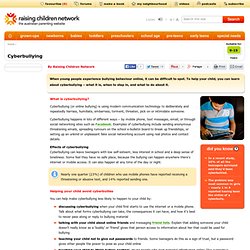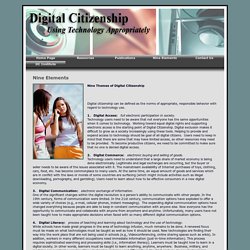

Digital Citizenship in Schools. The Alannah and Madeline Foundation. Cyberbullying. What is cyberbullying?

Cyberbullying (or online bullying) is using modern communication technology to deliberately and repeatedly harrass, humiliate, embarrass, torment, threaten, pick on or intimidate someone. Effects of cyberbullyingCyberbullying can leave teenagers with low self-esteem, less interest in school and a deep sense of loneliness.
Some feel they have no safe place, because the bullying can happen anywhere there’s internet or mobile access. It can also happen at any time of the day or night. Nearly one quarter (23%) of children who use mobile phones have reported receiving a threatening or abusive text, and 14% reported sending one. Helping your child avoid cyberbullies You can help make cyberbullying less likely to happen to your child by: A recent study suggested that 20% of teenagers have engaged in cyberbullying behaviour at some point. Calculate Your "Digital Footprint" with New Tool from EMC.
Earlier this month, EMC released their findings regarding the digital universe in a publication entitled "The Diverse and Exploding Digital Universe.

" Some of the research focused on mind-blowing figures - like the 281 billion GB size of the digital universe or the predicted size of the digital universe by 2011, nearly 1.8 zettabytes (1,800 exabytes). However, what really peaked our interest was information provided on your "Digital Shadow," that is, all the digital information generated about an average person on a daily basis. You may already be familiar with the term "digital footprint," which you probably take to mean your online data trail. If asked to describe what would comprise this "footprint," likely responses would include things like your social network profiles, your web site or blog, your photos shared on an online service, videos you uploaded to YouTube, perhaps even mentions of you in the local paper or your school's web site.
Videos. Recovered Cool web 2.0 tools for educational use. Photos de Phil Cartwright. Creating a PLN. Skip to content Building your PLN Know it or not, you already have some sort of Personal Learning Network or PLN! It could be your colleagues, family, students, friends – whoever! But with the power of the web and online collaboration – a PLN could really grow! This series guides you step by step through the process of building your PLN.
You can work through the activities in any order and at any time. Here is our guide to growing your PLN in as little as a couple of weeks! Sign Up For Free Powered by WordPress | Hosted by Edublogs | Protected by CloudFlare AddThis Sharing Sidebar Share to Facebook , Number of shares76 Share to TwitterShare to LinkedIn , Number of shares Share to EmailMore AddThis Share options , Number of shares65 Hide Show AddThis FollowShare Toggle Dock Share Close AddThisPrivacy. Nine Elements. Nine Themes of Digital Citizenship Digital citizenship can be defined as the norms of appropriate, responsible behavior with regard to technology use. 1.

Digital Access: full electronic participation in society. Technology users need to be aware that not everyone has the same opportunities when it comes to technology. Working toward equal digital rights and supporting electronic access is the starting point of Digital Citizenship. 2. 3. 4. 5. Bullying:The Big March. Techconnects - Digital Citizenship and Literacy. Digital citizenship - ePortfolio. As part of the support we wish to provide to USQ staff and students, I am investigating how cybersafety, digital citizenship and online safety generally needs to be included in USQ courses.

There are three elements to my thinking. 1. Pre-service teachers need to know about, commit to and practice online etiquette and guard themselves against unwanted online approaches and behaviour. This probably extends to knowing how to use technical tools to guard against viruses, spyware and malicious computer attacks. It probably includes awareness of online scams and other ways in which people are "ripped off" in everyday online life. Understanding your digital footprint and its impact now and in the future is part of this story. In some ways this awareness raising is the content, we need to include in USQ courses. 3. Fishbone diagram of ideas Click here for fishbone diagram.